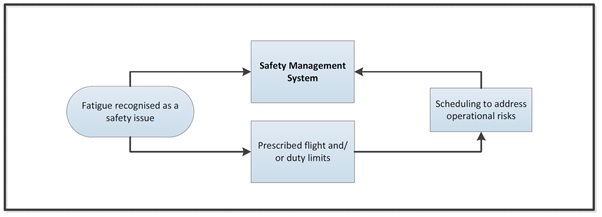Prescriptive limitation regulations identify maximum work periods and minimum non-work periods for specific groups of aviation professionals. Within these limits, operators must manage their fatigue-related risks as part of their existing safety management processes. The prescriptive approach to fatigue management is summarised in the following figure.

In order to support operators' efforts to identify specific fatigue risks and select appropriate mitigations, airlines should first consider the impact of the four key scientific principles.
These basic principles relate to: 1) the need for sleep; 2) sleep loss and recovery; 3) circadian effects on sleep and performance; and 4) the influence of workload, and can be summarized as:
- Periods of wake need to be limited. Getting enough sleep (both quantity and quality) on a regular basis is essential for restoring the brain and body.
- Reducing the amount or the quality of sleep, even for a single night, decreases the ability to function and increases sleepiness the next day.
- The circadian body clock affects the timing and quality of sleep and produces daily highs and lows in performance on various tasks.
- Workload can contribute to an individual's level of fatigue. Low workload may unmask physiological sleepiness while high workload may exceed the capacity of a fatigued individual.
Using these basic scientific principles will assist airlines to identify their contextual fatigue risks both now, and as they increase their operations, in order to develop suitable mitigations.
Go back
